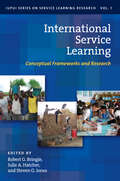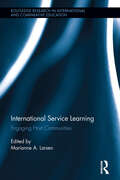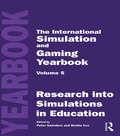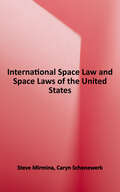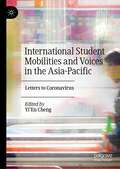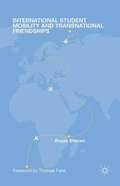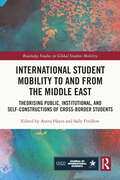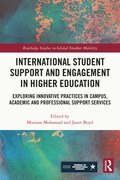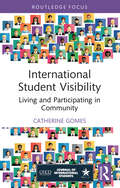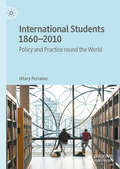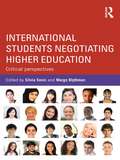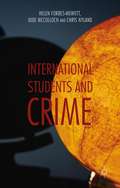- Table View
- List View
International Schools and International Education: Improving Teaching, Management and Quality
by Mary Hayden Jeff ThompsonThis work tackles the issues that staff and management of international schools need to address in order to ensure that their teaching and organization is of a high standard and quality. It contains a wide range of contributions from international school experts around the world.
International Schools, Teaching and Governance
by Carmen BlythThis book examines how injustice based on social positioning is performed within the context of international schools. Drawing on the lived experiences of an international school teacher, it proposes and explores the notion that teachers, in being constituted and positioned as subordinate within the hierarchy that is the international school, leads to their being wronged on three counts: epistemically for being wrongfully mistrusted; ethically for being wrongfully excluded; and ontologically for being wrongfully positioned as a lesser human being. The book addresses the dearth of research currently available on conflict in international schools and how conflict between teachers and administrators is dealt with in and by such institutions. It will be valuable reading for students and teachers of education and sociology, and those interested in the workings of international schools.
International Service Learning: Conceptual Frameworks and Research
by Robert G. Bringle Julie A. Hatcher Steven G. JonesInternational Service Learning (ISL) borrows from the domains of service learning, study abroad, and international education to create a new pedagogy that adds new and unique value from this combination. It is a high-impact pedagogy with the potential to improve students’ academic attainment, contribute to their personal growth, and develop global civic outcomes. The international service experience provides opportunities for additional learning goals, activities, and relationships that are not available in a domestic service learning course or in a traditional study abroad course. The service experience develops reflection while shedding light on and providing an added dimension to the curricular component of the study abroad course. The international education component further broadens students’ perspectives by providing opportunities to compare and contrast North American and international perspectives on course content.This book focuses on conducting research on ISL, which includes developing and evaluating hypotheses about ISL outcomes and measuring its impact on students, faculty, and communities. The book argues that rigorous research is essential to improving the quality of ISL’s implementation and delivery, and providing the evidence that will lead to wider support and adoption by the academy, funders, and partners. It is intended for both practitioners and scholars, providing guidance and commentary on good practice. The volume provides a pioneering analysis of and understanding of why and under what conditions ISL is an effective pedagogy.Individual chapters discuss conceptual frameworks, research design issues, and measurement strategies related to student learning outcomes; the importance of ISL course and program design; the need for faculty development activities to familiarize faculty with the component pedagogical strategies; the need for resources and collaboration across campus units to develop institutional capacity for ISL; and the role that community constituencies should assume as co-creators of the curriculum, co-educators in the delivery of the curriculum, and co-investigators in the evaluation of and study of ISL. The contributors demonstrate sensitivity to ethical implications of ISL, to issues of power and privilege, to the integrity of partnerships, to reflection, reciprocity, and community benefits
International Service Learning: Engaging Host Communities (Routledge Research in International and Comparative Education)
by Marianne A. LarsenInternational service learning (ISL) programs are growing more popular with students looking to advance their skills and knowledge to become global citizens. While the benefits of these programs among students are well documented, little is known about the implications they have on host communities themselves. This volume explores the impact of ISL programs on members of host communities (e.g. host families and local partner NGOs) who are increasingly influenced by the presence of international students in their lives. Drawing upon post-colonial, feminist and other critical and decolonizing theories, it examines the complicated power relations between North American ISL students and host communities in East and West Africa, the Caribbean and Central America. It stresses the importance of developing trusting relations between ISL students, faculty and individuals in the host communities to create mutually engaging learning experiences.
International Simulation and Gaming Research Yearbook: Simulations and Games for Emergency and Crisis Management
by John Rolfe Danny Saunders Tony PowellThe theme of this volume is emergency and crisis management and how games and simulations are effective tools in dealing with these issues. The work brings together topical contributions from international figures in the field of games and simulations.
International Simulation and Gaming Yearbook
by Peter Saunders Benita CoxThis text brings together topical contributions from figures in the field of games and simulations, representing the current international thinking and best practice.
International Space Law and Space Laws of the United States
by Steve Mirmina Caryn SchenewerkThis book provides helpful practice tips for representing clients and doing business in today's commercial space industry, as well as important coverage of the essentials for students of Space Law. Each chapter explores a nuanced space law issue and concludes with review questions. Written by two Georgetown Space Law professors who are also Space Law practitioners with more than 50 years of combined expertise having worked as legal counsel for NASA, in the halls of Congress, and in the Executive Branch, this book explains complex regulations in approachable language and is thoroughly annotated. This work is valuable for students of Space Law as well as practitioners. It will serve as a handy desk reference for years to come.
International Student Connectedness and Identity
by Catherine Gomes Ly Thi TranThis book focuses on the interrelationship between international student connectedness and identity from transnational and transdisciplinary perspectives. It addresses the core issues surrounding international students' physical and virtual connectedness to people, places and communities as well as the conditions that shape their transnational connectedness and identity formation. Further, it analyses the nature, diversity and complexity of international student connectedness and identity development across different national, social and cultural boundaries.
International Student Education in Tertiary Settings: Interrogating Programs and Processes in Diverse Contexts
by Zuocheng Zhang Trevor Grimshaw Xingsong ShiInternational Student Education in Tertiary Settings addresses key issues in international student education programme design and implementation. It maps contemporary theories and practices in international students’ transcultural learning and engagement and showcases successful tertiary education programmes for international students in Australia, China, Japan, the USA and the UK. The book highlights the opportunities for engaging international students that are built into the various programmes, international students’ strategies for coping with various challenges of engagement with their educational programmes, and a range of factors that confound their engagement in academic and intercultural learning. The broad coverage of international education programmes in a variety of geographical, sociocultural and pedagogical settings enables the discussion about the complexity of contemporary international student education, shared challenges and productive ways of engaging international students in transcultural learning and the prospect of sustainable engagement. The principles and insights into programme design and implementation to engage international students will be useful for researchers and practitioners in international student education, academics tasked with teaching international students in their class, and administrators responsible for managing and providing services to international students.
International Student Employability: Narratives of Strengths, Challenges, and Strategies about Global South Students (Knowledge Studies in Higher Education #12)
by Rosalind Latiner Raby Krishna Bista Jasvir Kaur Nachatar SinghThis book explores how international undergraduate and graduate students navigate their higher educational institutional (HEI) experiences and employability prospects in both Global North and Global South universities. The chapter authors examine how students from the Global South use their agency to apply their HEI experiences to meet their needs, gain skills, and envision alternative pathways to adapt to economic, environmental, and political changes.Through diverse student voices, the book sheds light on the challenges faced by these international students in the job market. It highlights the importance of promoting diversity and equity in higher education. The book emphasizes the need to consider the cultural circumstances of global south students to enhance their employability. The book contributes to a deeper understanding of the challenges and opportunities faced by Global South international students in the job market. It offers effective strategies for educators, policymakers, and employers to support these students.
International Student Engagement: Strategies for Creating Inclusive, Connected, and Purposeful Campus Environments
by Chris R. Glass Rachawan Wongtrirat Stephanie BuusThis book responds to the growing calls among international educators, activists, and students themselves to pay closer attention to the qualitative dimensions of international students’ experiences at U.S. colleges and universities. This book outlines deep approaches to the academic and social integration of international students at U.S. colleges and universities. It describes concrete examples of strategies to enhance the international student experience across a wide range of institutional types, and explores actions that have enabled colleges and universities to create more inclusive, connected, and purposeful campus environments for international students. It fleshes out the effects of these actions through the first person narratives of international students themselves. It focuses on reinforcing an institution’s existing strengths and capacities to help academic leaders at these institutions to develop comprehensive strategies that will enable the creation of inclusive campus climates for international students.The book combines evidence derived from the national Global Perspective Inventory dataset, the experiences of institutions at the forefront in developing effective strategies, as well as first-person narrative experiences of international students to illustrate the real-life consequences of institutional policies, practice, and programs.One of the aims of this book is to take readers on a journey, from community colleges to liberal arts institutions to large public flagship research universities, from rural parts of the U.S.to highly-populated urban areas in order to raise questions about the impact of the surge of international students in these environments and about the corresponding challenges that confront senior administrators seeking to strengthen and deepen connections for the students. The book explores some of the actions that universities and colleges across the U.S. have taken to create more inclusive, connected, and purposeful campus environments for their international students, placing particular emphasis on the importance of tapping and reinforcing each institution’s existing strengths and capacities in the development of strategies that will enable it to create more inclusive campus climates for current and incoming international students, and engaging in active collaboration with all departments and offices across the campus, with the larger community, and most important, with the international student community itself.
International Student Mobilities and Voices in the Asia-Pacific: Letters to Coronavirus
by Yi’En ChengThis edited volume explores core questions on education and transnational mobility in a time characterized by a global pandemic, recasting them through the lenses of regimes, experiences, and aspirations. The volume brings together 19 short essays in the form of letters addressed to the coronavirus and written by international students , together with nine striking illustrations that depict emotive scenes from the essays, and nine academic commentaries that analytically link these personal narratives to broader societal structures. This book represents a timely intervention, providing an intimate glimpse into young people’s hopes and the challenges they face concerning their education and mobility.
International Student Mobility and Access to Higher Education (Marketing and Communication in Higher Education)
by Paul M.W. Hackett Or Shkoler Edna Rabenu Paul M. CapobiancoThis book offers a comprehensive look into issues and trends driving international student mobility as the phenomenon becomes increasingly prevalent worldwide. Chapters first present an expanded definition of student mobility in the context of internationalization and go on to discuss the underlying motivations, issues, and challenges students face in attaining successful outcomes. The authors employ marketing concepts to illustrate ideas and recommendations for better attracting and integrating international students into academic institutions abroad with the goal of greater satisfaction for students and improved profitability for the universities they attend.
International Student Mobility and Transnational Friendships
by Basak BilecenFriends play a crucial role in international students' lives. This book explores the characteristics of the friendship networks of international doctoral students by analysing the relationships between these students and their friends, both in the country of education and across several national borders.
International Student Mobility in Higher Education: Case Studies in Agency
by Jason C. SchneiderThis book offers an in-depth look at the experiences of international students as they pursued undergraduate degrees in the US. Drawing on recurring interviews with the students and other qualitative data collected over four years, the book investigates how the students’ academic development intersected with other life factors, including their status as international students, their linguistic backgrounds, the challenges of functioning in a new sociocultural environment, and the circumstances of living in the US on a student visa. In sum, the book presents an understanding of the students as agentive young adults who exerted great effort to make US higher education align with their own desires for spatial, ideological, and socioeconomic mobility.
International Student Mobility in Japan: Higher Education in the Era of the New Normal (Routledge Research in Education Policy and Politics)
by Ryoko Nakano Akito Okada Yu SengokuIn light of the COVID-19 crisis, this edited volume explores the changing landscape of International Student Education in Japanese universities and the impact on global student mobility.Through analysing a wide range of data, the book engages historical, cultural, linguistic and pedagogical contexts relating to higher education in Japan. With a particular focus on Japanese tertiary education, the chapters provide comprehensive analysis from surveys and interviews conducted since 2020 amongst Japanese and non-Japanese Higher Education institutions (HEIs) on leadership styles, decision-making behaviours and perspectives on higher education practices in Japan. The authors also examine the challenges and impact on student mobility and international student education, and present future directions for the internationalisation of higher education in post-pandemic Japan.This book will appeal to researchers, educators and anyone with an interest in higher education development, international student mobility and language learning.Chapters 5 and 9 of this book are freely available as a downloadable Open Access PDF at http://www.taylorfrancis.com under a Creative Commons [Attribution-Non Commercial-No Derivatives (CC BY-NC-ND)] 4.0 license. The publication of these chapters as an open-access work was generously supported by the Japan Society for the Promotion of Science (JSPS) through the Grants-in-Aid for Scientific Research (KAKENHI) [Grant Number JP20KK0052].
International Student Mobility to and from the Middle East: Theorising Public, Institutional, and Self-Constructions of Cross-Border Students (Routledge Studies in Global Student Mobility)
by Aneta HayesThis volume investigates how international students in and from the Middle East are constructed by nations, institutions, other students, and themselves. Making a valuable contribution to understanding the nuances and complexities of educational politics and priorities affecting these constructions, the text considers the broader impacts of discourse on internationalisation. Offering a unique combination of critical analysis of educational policies combined with empirical contributions through authors’ own research, chapters highlight intersections between politics, the internationalization of higher education, and the construction of mobile learners. Emphasizing variation and nuance in the internationalization of policies in the Gulf Cooperation Countries, Syria, Israel, and Turkey, the volume offers a theoretical framework to help understand the political, educational, and ethical implications of emerging constructions of international students and their comparison across the Middle East. This timely volume will benefit researchers, academics, and educators with an interest in higher education, international and comparative education, as well as the Middle East more specifically. Those involved with educational education policy and politics, specifically related to the Middle East, will also benefit from this volume.
International Student Recruitment and Mobility in Non-Anglophone Countries: Theories, Themes, and Patterns (Internationalization in Higher Education Series)
by Hans De Wit Ekaterina Minaeva Lizhou WangInternational Student Recruitment and Mobility in Non-Anglophone Countries offers a detailed analysis of global dimensions and trends in international student mobility and recruitment. It examines current data on student flows, policies and instruments, obstacles and opportunities for recruitment, and the roles of multiple stakeholders from different parts of the world. Considering the current geopolitical developments and tensions, increased competition for global talent, health and sustainability concerns, growing nationalism, and other factors, non-Anglophone countries are likely to increase their recruitment efforts moving forward. This book highlights the initiatives and instruments of these countries to attract international students and build long-term internationalization strategies. With case studies from Africa, Asia, Europe, the Middle East, and Latin America, International Student Recruitment and Mobility in Non-Anglophone Countries is a must-read text for international education policy advisors at the national and institutional levels and in the international higher education industry around the globe.
International Student Support and Engagement in Higher Education: Exploring Innovative Practices in Campus, Academic and Professional Support Services (Routledge Studies in Global Student Mobility)
by Mutiara Mohamad Janet BoydInternational Student Support and Engagement in Higher Education examines innovative practices in campus, academic, and professional support services which serve the various and unique needs of international students seeking undergraduate and graduate degrees. Divided into three sections pertaining to campus, academic and professional support services, the authors present case studies and original research that examine strategies for how institutions of higher education can operate to promote international student success beyond the classroom. The international range of contributors showcase research from across Canada, China, Indonesia, Malaysia, Russia, Senegal, Thailand and the US. Foregrounding support services with innovative and successful methods for collaborating with one another, the book crucially addresses how the myriad support services available on campuses can work together to support international students and foster a sense of belonging and connection, rather than maintaining a focus on acculturation. It examines the origins of these partnerships, asking whether the services are designed to support the international student community specifically, or to serve the student population more generally. Identifying new emerging trends and with a view to establishing a broad and global context for best practices in international student support, this book will appeal to faculty, researchers, scholars, and scholar-practitioners with interests in higher education, student support services and international and comparative education.
International Student Visibility: Living and Participating in Community (Routledge Studies in Global Student Mobility)
by Catherine GomesThis book narrates the ubiquitous relationship that international students have with their destination community, asking why students are not part of these communities despite being visible actors not only as students but as neighbours and as workers in the service industries and the gig economy.This book examines international students living and working in Australia through a cultural and communications lens, bringing together almost a decade of interviews and online surveys. It provides insight into their transnational identities and social and cultural practices in real-world and digital spaces. Despite being an integral part of the ethnographic landscape of the places they occupy, this book argues that international students are often not an integrated part of the wider community. To remedy this, international students have found ways to explore and communicate their experiences as transient migrants in Australia. This book thus goes beyond canonical academic commentary on the international student experience – which often views them as vulnerable migrants – to suggest that students create a sense of community and belonging while providing the wider Australian public insights into the international student experience through the creative arts.This book will appeal to scholars, upper-level students, and researchers with interests in international and comparative education, sociology of education, urban education, cultural studies, migration studies, and youth studies.
International Students 1860–2010: Policy and Practice round the World
by Hilary PerratonThis book describes how the number of international students has grown in 150 years, from 60,000 to nearly 4 million. It examines the policies adopted towards them by institutions and governments round the world, exploring who travelled, why, and who paid for them. In 1860 most international students travelled within Europe; by 2010 the largest numbers were from Asia. Foreign students have shaped the universities where they studied, been shaped by them, and gone on to change their own lives and societies. Policies for student mobility developed as a function of student demand and of institutional or national interest. At different times they were influenced by the needs of empire, by the cold war, by governments' search for soft power, by labour markets, and by the contribution students made to university finance. Along with university students, others travelled abroad to study: trainee nurses, military officers, the most deprived and the most privileged schoolchildren. All their stories are a vital part of the world's history of education and of its broader social and political history.
International Students And Scholars In The United States
by Heike C. Alberts Helen D. HazenAn international team of academics and experienced practitioners here bring together scholarship on academic migrants to the United States - the world's top recipient of academic talent. They examine the multidirectional migration patterns of academic migrants, adaptation challenges, and the roles played by international students and faculty.
International Students Negotiating Higher Education: Critical perspectives
by Silvia Sovic and Margo BlythmanIn the current economic climate, more than ever, international students provide an important income to universities. They represent much-needed funds for many institutions, but they also come with their own diverse variety of characteristics and requirements. This insightful book offers a critical stance on contemporary views of international students and challenges the way those involved address the important issues at hand. To do this, the authors focus specifically on giving voice to the student experience. In particular, the authors show how international student experience can be a ready asset from which to glean valuable information, particularly in relation to teaching and learning, academic support and the formal and informal curriculum. In this way, the issues affecting international students can be seen as part of the larger set of difficulties that face all students at university today. Integrating contributions from a academics and student voices from a range of backgrounds issues raised include: Academic Writing for International Students The Internationalisation of the Curriculum Identities: The use of stereotypes and auto-stereotypes International Students’ Perceptions of Tutors, and The system in reverse, English speaking learners as 'international students'. This book will be of interest to education management and administrators, higher education professionals, especially those working or training to teach large numbers of international students, to which it offers a unique opportunity to understand better the students’ point-of-view. Because of this the book will likely appeal to academics in all English speaking countries that recruit significant numbers of international students, as well as the growing number of European universities which teach in English and those in the Indian sub-continent that send large numbers of international students to the UK, Australia, New Zealand and the US.
International Students and Crime
by Helen Forbes-Mewett Jude Mcculloch Chris NylandInternational students and crime is of major international concern, impacting on lucrative international student markets, international relations, host countries' reputations as tolerant and safe, and on the security of students and the public. While crimes against and by international students have attracted a deal of media attention and discussion internationally, there is little research that systematically describes, analyses and reflects on the phenomena. International Students and Crime analyses a spectrum of crime from petty theft to kidnapping and murder, presenting vital knowledge about international students as victims and perpetrators of crime in the US, the UK and Australia. It highlights the largely hidden phenomena of crimes against female international students and strategies students use to stay safe. Examining the different approaches to student safety in host countries, the book considers the ways in which governments, higher education providers and police approach and implement their responsibilities for international student safety.
International Students and Global Mobility in Higher Education
by Rajika Bhandari Peggy BlumenthalThis book examines current trends in global student mobility patterns in several key host and destination countries, including the United States, China, India, South Africa, Mexico, Australia, and Germany, among others, and will explore the national and global-level factors that contribute to these trends.


